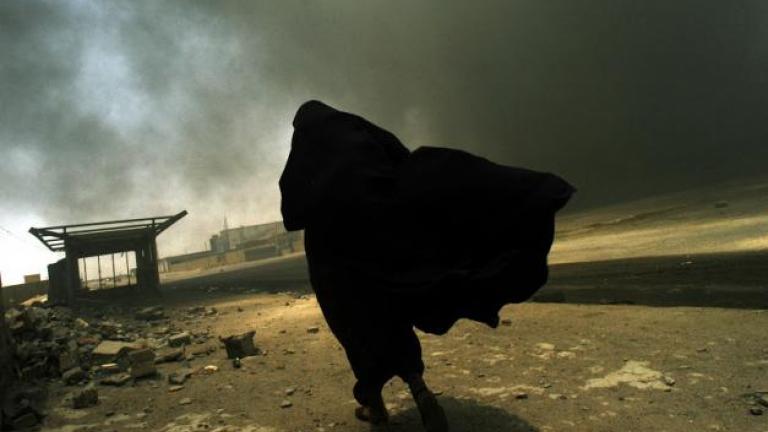Imagine you’re 42 years old and Steven Spielberg just agreed to direct the story of your life with actress Jennifer Lawrence in the lead. It’s incredible, but true: Combat photographer Lynsey Addario has led a life that has been anything but ordinary.
Addario recently visited town as a guest of the Chicago educational group Facing History. We spoke with her about her years of living dangerously.
Soldiers with the 173rd battle company, looking for caves, weapons caches and known Taliban leaders on a battalion-wide mission in the Korengal Valley in Afghanistan. (Lynsey Addario)
From Iraq to Libya to the Congo, Addario has carried her camera to the heart of conflict.
“Most people think that war photogs are adrenaline junkies, and I think that there is so much more that drives people like me,” Addario said. “I go into all of these stories trying to give voice to the people who are in these situations of war, whether they’re civilians or covering the military—whoever it is—I’m trying to convey their perspective. I’m always trying to think of, ‘How do I cover this situation in a way that will actually pull the reader in, rather than make them turn away.’”
A graduate of the University of Wisconsin, Addario’s first big story was photographing women under the Taliban in 2001—before 9/11.
An Iraqi woman walks through a plume of smoke rising from a massive fire as she searches for her husband in Basra, Iraq, May 26, 2003. (Lynsey Addario / Corbis Saba)
“I started out photographing war primarily out of curiosity, and the first trip I made was to Afghanistan under the Taliban,” Addario said. “And I’d heard that the women were living under the Taliban under severe repression and I sort of saved my money and went to Afghanistan. I was 26 years old and was curious. And then when we were gearing up for the war in Iraq in 2003, I felt like I wanted to be there. I wanted to witness what was happening, not only with our own troops, but with Iraqis and civilians.
"So I went in and I ended up staying for two years in Iraq, basically, I spent the better part of two years there. And at that point, when I started realizing what impact the images I was taking for the New York Times and Time magazine—the impact they were having on policy and policymakers, and on public opinion—then I sort of realized, ‘OK, this is something that is larger than me.’”
Two women from Weha Village in Afghanistan wait on the side of the road for transportation to the hospital after their vehicle had broken down during the four-hour commute. One of the women is pregnant with her first child and her water has just broke. (Lynsey Addario)
Addario told her story in the 2015 memoir “It’s What I Do.” And that story caught the attention of Hollywood.
“It’s been optioned by Warner Bros. and Steven Spielberg will be directing and Jennifer Lawrence will be playing me, which is a very odd thing to say,” Addario said. “I don’t think I’ve ever vocalized that before, but yeah.”
Opposition troops burn tires to use as cover during heavy fighting, shelling, and airstrikes in Eastern Libya, March 11, 2011. (Lynsey Addario / New York Times)
On the job, Addario has been kidnapped twice, physically abused and threatened with death. She is the rare combat photographer who is a woman.
“I personally find it a great advantage being a woman,” Addario explained. “Look, bullets don’t discriminate by gender, they don’t say like, ‘Oh, OK I’m gonna go for the woman,’ but you do have to be very agile and physically fit and be quick and quick-thinking. But a lot of war coverage is based on your intuition, anticipating what’s happening next and being familiar with the situation.
“So those are all things that, it doesn’t matter if you’re a man or a woman, you just have to be smart about how you work. So people often say, ‘You know, there aren’t many women, is it a great disadvantage?’ Well, no. I think that also I have access to women in the Muslim world in a way that my male colleagues don’t.”
Sudanese women await items being distributed by international humanitarian organizations after their village was bombed and attacked by the Sudanese government in West Darfur, Sudan, February 28, 2008. (Lyndsey Addario / New York Times)
Addario speaks of staying calm under pressure.
“Every time I’m in a situation where I think, ‘OK this is it, I’m not going to make it out of the situation alive,’ I sort of shut down. I almost go into a very calm mode ironically, and very Zen, and very much like, ‘OK, I have to get through every single second,’” Addario said. “I tend to deal with trauma by talking about it—almost ad nauseam. I come from a big Italian expressive family and I’ve been taught to communicate very openly since I was very young and, for me, that is a huge help in terms of processing trauma.”
Captain Dan Kearney watches over his troops in the 173rd battle company and controls close air support fire from above the village of Yakachina in the Korengal Valley, Afghanistan. (Lynsey Addario)
Her latest work looks at the refugee crisis in Europe and the Middle East.
“I want people to care about issues they wouldn’t necessarily care about, whether that’s war, racism, civilian casualties—just general injustices,” Addario said. “For me, the moment is when I start working and everything else is sort of moving to get to that moment.”
In this web-exclusive video, Addario talks about how she navigates risk when photographing war.
Below, more photographs taken by Addario:



